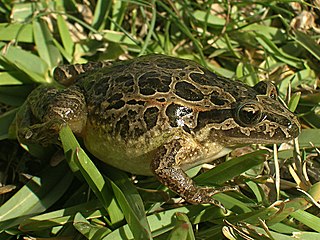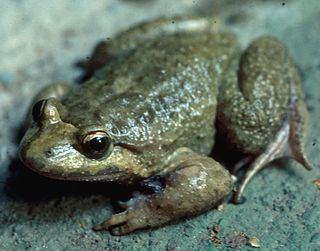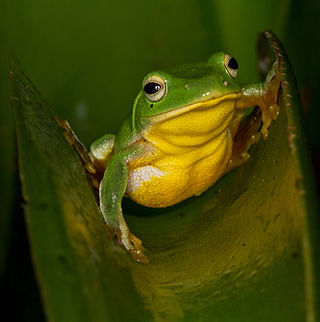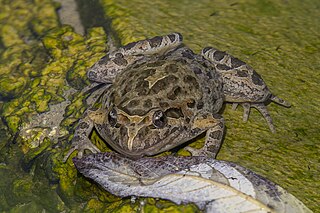
The Corsican brook salamander or Corsican mountain newt is a species of salamander in the family Salamandridae. It is endemic to Corsica, an island in the Mediterranean Sea.

The Iberian midwife toad or brown midwife toad, in Portuguese sapo-parteiro-ibérico, is a species of frog in the family Alytidae found in Portugal and western Spain. It is typically found in open habitats such as meadows and open oak forests. Habitat loss is one of the threats to its survival.

The Betic midwife toad or Sapo Partero Bético is a species of frog in the family Alytidae. It is endemic to mountainous in south eastern Spain. Its natural habitats are temperate forests, freshwater marshes, intermittent freshwater marshes, pastureland, ponds, and aquaculture ponds. It is threatened by habitat loss.

The Iberian painted frog is a species of frog in the family Alytidae. It is found in Portugal and Spain, where its natural habitats are temperate forests, temperate shrubland, Mediterranean-type shrubby vegetation, rivers, intermittent rivers, swamps, freshwater marshes, intermittent freshwater marshes, sandy shores, arable land, and grassland. It is threatened by habitat loss.

The Spanish painted frog, in Spanish sapillo pintojo meridional, is a species of frog in the family Alytidae. It is endemic to Spain.

The Corsican painted frog is a species of frogs in the family Alytidae.

The Sardinian tree frog or Tyrrhenian tree frog is a species of frog in the family Hylidae, found in Corsica, Sardinia, and the Tuscan Archipelago.

Hyperolius ocellatus is a species of tropical West African frog in the family Hyperoliidae, that is split into the subspecies H. o. ocellatus and H. o. purpurescens. It is found in Angola, Cameroon, Central African Republic, Republic of the Congo, Democratic Republic of the Congo, Equatorial Guinea, Gabon, Nigeria, Uganda, and possibly Rwanda. Its natural habitats are subtropical or tropical moist lowland forests, rivers, intermittent freshwater marshes, freshwater springs, rural gardens, heavily degraded former forest, ponds, and canals and ditches.

Hylodes sazimai is a species of frog in the family Hylodidae. It is endemic to Brazil. Its natural habitats are subtropical or tropical moist lowland forest, subtropical or tropical moist montane forest, and rivers. It is threatened by habitat loss.

Breviceps fuscus, also known as black rain frog, plain rain frog, brown short-headed frog, and Tsitsikamma rainfrog, is a species of frogs in the family Brevicipitidae. It is endemic to the southern coast of South Africa.
Phrynobatrachus scapularis is a species of frog in the family Phrynobatrachidae. It is endemic to the northern and northeastern Democratic Republic of the Congo. The specific name scapularis refers to shoulder blades (scapulae). Common name Buta river frog has been coined for it.
Platymantis indeprensus is a species of frogs in the family Ceratobatrachidae.

The Italian pool frog is a species of frog in the family Ranidae. Found on the mainland of Italy and the Mediterranean islands of Sicily, Elba, Corsica and Sardinia, its natural habitats are rivers, swamps, freshwater lakes and freshwater marshes. It is not considered threatened by the IUCN.

The Taipei tree frog is a species of frog in the family Rhacophoridae. It is endemic to central and northern Taiwan. It is a medium-sized tree frog; females are 4.5–5.5 cm (1.8–2.2 in) in snout-vent length, and males are slightly smaller 3.5–4.5 cm (1.4–1.8 in).

Discoglossus pictus, the Mediterranean painted frog or simply painted frog, is a species of frog in the family Alytidae.
Pseudophilautus newtonjayawardanei is a species of frogs in the family Rhacophoridae, endemic to Sri Lanka.

The Acqua Tignese is a stream in the Haute-Corse department of the Corsica region that has its mouth north of Cap Corse, in the Ligurian Sea.

The Ospedale Reservoir is a reservoir in the Corse-du-Sud department of France on the island of Corsica. It holds drinking water for the southeast of the island, including Porto-Vecchio. It is surrounded by a forest that has been designated a Zone naturelle d'intérêt écologique, faunistique et floristique (ZNIEFF).

The Santu River is a small coastal river in the department of Haute-Corse, Corsica, France.


















